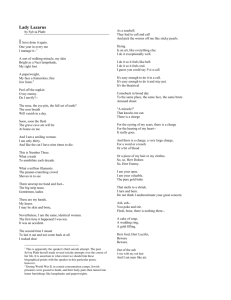

This poem has always fascinated me in terms of the figurative language and the ever-precise vocabulary that is used. The poem serves as a metaphor that retains a morbid sensation through its description of the author’s psychological journey. In recording her previous suicide attempts, she makes comparisons that are not always obvious to decipher or to understand without the right background information. “Lady Lazarus” conveys a message about her own life, obsessions, weaknesses, and feelings. During this feverish period of her life, “Lady Lazarus” and other poems of that genre were written. Soon enough, Sylvia returned to her old suicidal habits. However, after having their first child, their relationship started to go stale, and finally adultery on both their parts caused their painful separation. She recovered from her nervous breakdown and met her to-be husband, renowned poet Ted Hughes, three years later. Twenty-year-old Plath committed her first near-successful suicide attempt after a whole month of not being able to sleep, write or eat properly. It has also been known to have caused the poet to hate her father for the pain his death inflicted on her. This event in her life is what most specialists believe to have triggered her depressive tendencies. In Bram Stoker's Dracula (1897) the vampire returns from the dead to sustain himself on the blood of his victims, but offers no account of how he feels.We will write a custom essay on Poem Analysis of Lady Lazarus by Sylvia Plath specifically for youĪ few days after she turned eight, her father deceased of diabetes. In Edgar Poe's stories "Berenice" (1835) and "Ligeia" (1838) the living are nearly dead and the dead, with a remnant of consciousness, still living.

But the inquisitors remain alive and the dead remain dead. In Homer, Virgil and the Inferno, Odysseus, Aeneas and Dante visit the Underworld, interview the dead about their posthumous existence and return to the terrestrial world. Many great writers have obliquely treated this morbid theme. And it does not tell us what sort of life Lazarus led before and especially after he was resurrected: prefiguring Jesus' own personal comeback. But the Gospel misses a great dramatic opportunity to describe how Lazarus felt when he came back from the dead -bound up with cerements like a mummy and with a piece of cloth to keep his mouth clamped shut. (The Lazarus in Luke 16: 19-37 is a different man.) His function is to show Jesus' miraculous powers and help convert the skeptical Jews. In the next chapter of John's Gospel, Lazarus sups with Jesus, Jews come to look at him, the chief priests plan to kill him and he remains corporal evidence of the miracle. Jesus said unto them, loose him, and let him go." The "loud voice" was not meant for Lazarus, who could have been summoned by a mere whisper, but to attract the attention of the gathering audience. And he that was dead came forth, bound hand and foot with grave clothes: and his face was bound about with a napkin.


Plath's title obviously refers to the passage in John 11:43-44: Jesus "cried with a loud voice, Lazarus, come forth.


 0 kommentar(er)
0 kommentar(er)
